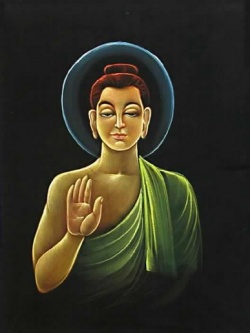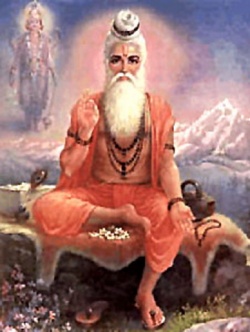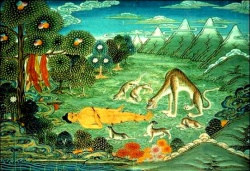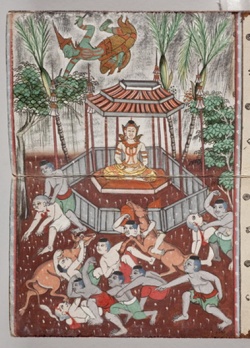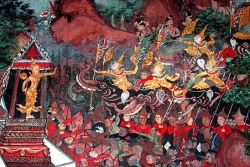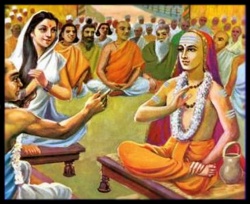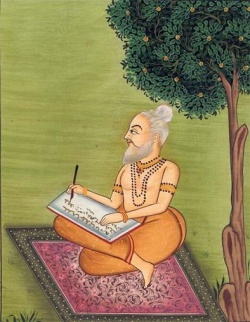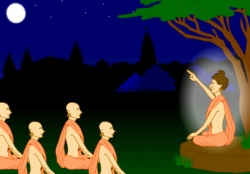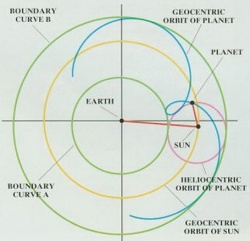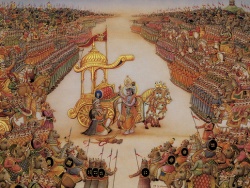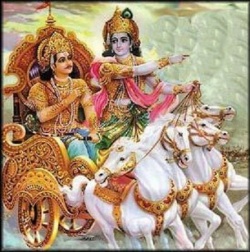Perception, Conceptual Construction and Yogic Cognition According to Kamalaśīla's Epistemology by Funayama Toru
- Abstract
The nature of direct perception (pratyakṣa 直接知覺;現量) is one of the most important topics in the Logico-Epistemological (pramāṇa) School of Buddhism in India. In this paper, I tried to give more or less a general explanation as to how direct perception is defined by Kamalaśīla 蓮華戒 (ca. 740-795 C.E.), one of the most brilliant scholar-monks of the school after the establishment of the philosophical system by Dharmakīrti 法稱 (ca. 600-660). In the course of analysis, the relation between direct perception and conceptual construction (kalpanā, 分別) was also elucidated. Dignāga 陳那 (ca. 480-540) defined conceptual construction as nāmajātyādiyojanā which usually means 'the connection of a name, genus, etc.' Dhārmakīrti, on the other hand, defined the same notion as 'a cognition associated with an expression' (abhilāpinī pratītiḥ). Interestingly enough, he did not explicitly state the relationship between his own definition and that by Dignāga. This fact urged Śāntarakṣita's and likewise his eminent disciple Kamalaśīla's serious examinations of the relationship between the two definitions. Indicating three different possible interpretations of Dignāga's definition, Kamalaśīla finally reached the conclusion that what was intended by Dignāga and Dharmakīrti was none other than the same.
Another basic difference discernible in Dignāga's and Dharmakīrti's epistemological views is the definition of direct perception itself. Namely, Dignāga defined direct perception as the cognition which is free from conception (pratyakṣaṃ kalpanāpoḍham;“現量除分別”according to Xuanzang's expression). Dharmakīrti added to it the further element 'non-erroneous'; i.e., (The cognition
p. 274
which is) free from conception and is non-erroneous is direct perception (pratyakṣaṃ kalpanāpoḍham abbrāntam). The second chapter of this paper was spent for the observations on the meaning of 'non-erroneous.'
In the third chapter, I pointed out a few problems underlying the definition of direct perception, especially in terms of yogic cognition (yogijñāna) or perception (yogipratyakṣa). Special attention was directed toward how one can meditate on religious truths such as “All beings are momentary” through direct perception without any intervention by conceptual construction. A careful examination of the passages in the Bhāvanākrama reveals that Kamalaśīla holds the opinion that the attainment of yogic perception, which should belong to mental cognition, and not to sense-perception, is realized when one reaches the first of the ten stages in the Mahāyāna bodhisattva praxis. Kamalaśīla was possibly the first person that gave an explicit and well-systematized statement as to how a yogic cognition defined by the Logico-Epistemological School should be related to the traditional Mahāyāna system of practice.
關鍵詞: 1.pratyakṣa 2.kalpanā 3.vikalpa 4.yogipratyakṣa 5.pramāṇa 6.Dhamakīrti 7.Kamalaśīla
【Contents】
- Introduction
I. Hermeneutics of 'Free from Conceptual Construction'
1. Connection with a name and a genus, etc.
2.Connection of a name through a genus, etc.; i.e., conception is that cognition which connects a name with the relevant object through the medium of a genus, etc., both of which are expressed from the Buddhist standpoint only.
II. The Meaning of 'Non-Erroneous'
III. Some Problems Underlying Yogic Perception
p. 275
Introduction
It is well known that there were four major schools in the history of Buddhism in terms of philosophy: the Sarvāstivāda School (alias Vaibhāṣika), the Sautrāntika School, the Yogācāra Vijñānavāda School and the Madhyamaka School. Of them, the second and the third sometimes formed a single school called the Sautrāntika-Yogācāra or the “Integrated School of the Sautrāntika and the Yogācāra” in the way that people of the school discussed various philosophical problems in the Sautrāntika point of view as long as the problem could be solved as a matter of our ordinary world, and only when they had the need to examine the ultimate condition of beings they shift their standpoint to the Yogācāra system. Thus it can safely be said that the Sautrāntika system was used by the school for the explanation of what is called vyvahāra or saṃvæti and the Yogācāra for the paramārtha level.
When about the vyavahāra-level, the main interest of this school is focused on neither salvation nor final emancipation but rather on how to explain the phenomena of our ordinary world in terms of logic and epistemology, such as the relationship between fire and smoke or how our knowledge takes place in connection with its object. Since such philosophical endeavor is fulfilled through the investigation of means of correct knowledge or valid cognition (pramāṇa) as distinguished from all other incorrect cognitions, this school is called by present researchers “the Pramāṇa School” or “the Logico-Epistemological School of Buddhism.”
The school produced two gigantic philosophers—one is Dignāga and the other Dharmakīrti. Of the two, Dignāga flourished in the period between ca. 480-540 C. E. He compiled his earlier work called the Nyāyamukha “The Gate to Logic,” paying special attention to logic. Taking into account the whole system of his philosophy, he finally rearranged his philosophy in his magnum opus, the Pramāṇasamuccaya “Corpus of Valid Cognitions.”
On the other hand, Dharmakīrti, who was active around 600-660, started his philosophical activities by writing a commentary, Pramāṇavārttika, on Dignāga's Pramāṇasamuccaya, and later developed his own views on some significant points through a modification of Dignāga's system. Such was set forth when he wrote the Pramāṇaviniścaya “The Ascertainment of the Means of Valid Cognition” on the basis of the Vārttika, the latter to be summarized in the Nyāyabindu “The Essence of
p. 276
Logic.” After that, he further developed his views on logic in the Hetubindu “The Essence of Reason” and the Vādanyāya “The Rules of Dialectics.”
As a means to describe our world correctly, Dignāga upheld only two kinds of valid cognition (pramāṇa): direct perception (pratyakṣa) and inference (anumāna).
Of the two kinds of valid cognition, direct perception is defined by Dignāga as pratyakṣaṃ kalpanāpoḍham “Direct perception is free from conceptual construction.” This is the starting point in my talk today. In Dignāga's system, direct perception is described in the relationship with conceptual construction (kalpanā, or alternatively vikalpa “conception”), as one of the most fundamental epistemological problems. In Buddhism, direct perception as correct knowledge meant a direct cognition which could not possibly contain any error, whereas conception was often considered to be the root of all evil and mental trouble in the ordinary lives of human beings. According to Dharmakīrti, for instance, conception (vikalpa) is equivalent to nescience (avidyā), whereas holy beings (saints, ārya) such as a yogin or the Buddha are regarded to be those who have annihilated the mesh of conceptual construction (vidhūtakalpanājāla-; cf. Funayama 1992: 44 n. 2).
It goes without saying that there are a number of explanations as to the nature of direct perception, and each school of not only Indian Buddhism but Indian Philosophy in general, has its own definition of pratyakṣa. I will not go into a comparison of those definitions. I would like to limit myself to considering the problem of the definition found in the Buddhist Pramāṇa School.
The tenets of the Pramāṇa School are based on basic theses of Buddhism such as “dependent origination” (pratītyasamutpāda) and the theory of the momentariness of phenomenal beings (kṣaṇabhaṅgavāda). This is true of the definition of valid cognition, as well. Direct perception is explained to be a cognition arising immediately after the occurrence of an object, which does not continue at all. It exists only for one moment and in the next moment, the image (ākāra) in our cognition is substituted by a very similar, but completely different cognition. For example, when we see a desk, we usually believe that we can continue to perceive the desk as a single entity, admitting the identity of the object for a certain length of time. However, such an assumption is wrong according to the Pramāṇa School. They claim that what there really is in our perceptual vision is a sequence of very similar, but completely different moments of time, which are
p. 277
wrongly constructed to be a duration/continuum (saṃtāna) of one and the same desk. In reality, the image of the desk manifests itself only in the very first moment after one perceives the object. Only the cognition in the first moment is called direct perception and the succeeding similar cognitions in later moments, which belong to conceptual construction, cannot be referred to as direct perception. This idea reveals that the school held a fundamental doubt concerning vikalpa or conceptual cognition in the sense that we cannot grasp the reality of ontological entities through the medium of our conceptual construction. Here, we notice a Mahāyānistic peculiarity as the background of the school's disbelief in conceptual construction.
How, then, one may ask is conceptual construction explained? Dignāga's answer to this question is found in the Pramāṇasamuccaya I 3d and its Vṛtti:
… yatra jñāne kalpanā nāsti tat pratyakṣam. atha keyaṃ kalpanā nāma.
nāmajātyādiyojanā //3d//
yadṛcchāśabdeṣu nāmnā viśiṣṭo 'rtha ucyateḍittha iti. jātiśabdeṣu jātyā gaur iti. guṇaśabdeṣu guṇena śukla iti. kriyāśabdeṣu kriyayā pācaka iti. dravyaśabdeṣu dravyeṇa daṇḍī viṣāṇīti... (cf. Hattori 1968: 25)
...That in which there is no conceptual construction is (called) direct perception. Then what is this 'conceptual construction'?
(It is) the connection with a name, genus, etc. //3d//
In the case of arbitrary words, a thing is expressed as being distinguished [from other things] by a name (as, for example,) Dittha. In the case of genus-words, (a thing is expressed as being distinguished) by a genus (as, for example,) cow (go). In the case of quality-words, (a thing is expressed as being distinguished) by a quality (as, for example,) white (śukla). In the case of action-words, (a thing is expressed as being distinguished) by an action (as, for example,) a cook (pācaka). In the case of substance-words, (a thing is expressed as being distinguished) by a substance (as, for example,) a staff-bearer (daṇḍin) or a horn-bearer (viṣāṇin). (cf. Funayama 1992: 76-77)
Here, what deserves our notice is the fact that in spite of Dignāga's Buddhist inclination to nominalism, the above explanation of kalpanā, especially the reference to śabda, jāti, guṇa, kriyā and so forth is closely related with the
p. 278
grammarian Patañjali's Mahābhāṣya (cf. Hattori 1968 p. 83f.) and also with the categorical padārtha-theory of the Vaiśeṣika School. Therefore, it is natural to conjecture that the followers of Dignāga's pramāṇa theory had a need to answer the question as to whether or not the above-mentioned definition can be interpreted only with the help of realistic philosophy, which looks to be quite an inappropriate stance for the Sautrāntika-Yogācāra.
After Dignāga, Dharmakīrti followed his predecessor's definition of direct perception, first in the Pramāṇavārttika without any changes and then in the Pramāṇaviniścaya I 4 and the Nyāyabindu I 4 with the following modification:
(tatra) pratyakṣam kalpanāpoḍham abhrāntam.
“(Of them,) Direct perception is free from conceptual construction and is non-erroneous.”
Coinciding with this change, he proposed his own definition of conception: abhilāpinī / pratītiḥ kalpanā “Conception is a cognition associated with an expression” in a part of verse (Pramāṇaviniścaya I 4bc); and abhilāpasaṃsarga-yogyapratibhāsā pratītiḥ kalpanā “Conception is a cognition whose manifestation is capable of connection with an expression,” more explicitly, but with the same connotation in prose in the Pramāṇaviniścaya and the Nyāyabindu I 5. These passages signify Dharmakīrti's idea that the real nature of existence cannot be expressed by any word, while conceptual thinking in our ordinary life is, by nature, none other than linguistic understanding of objects.
In this paper, I would like to pay special attention to the Tattvasaṃgraha “The Integration of Truths” by Śāntarakṣita (ca. 725-788) and its commentary, the Tattvasaṃgrahapañjikā “A Commentary on the Integration of Truths” by his eminent disciple Kamalaśīla (ca. 740-795). They both lived in the most active period of the Buddhist logico-epistemological tradition following Dharmakīrti. In both of their cases, the philosophical system of Dharmakīrti was fully accepted and absorbed within the tradition, on the one hand, and, on the other, after the full doctrinal setting of each orthodox school, Buddhists felt the need to refute those of their ideas which were opposed to Dharmakīrti's. Besides, even within the Buddhist party, differences in interpretation stimulated controversy concerning several points.
p. 279
As is well known, Śāntarakṣita and Kamalaśīla expressed their final standpoint as Madhyamaka, i.e. followers of the tenet “All beings are devoid of their own static nature” (sarvadharmāṇāṃ niḥsvabhāvatā). This stance is conspicuous in the Madhyamālaṅkāra by Śāntarakṣita and the Madhyamakāloka by Kamalaśīla, both of which were composed in their later days probably at bSam yas, Tibet. On the other hand, very little evidence for their position as Madhyamaka can be detected in the case of the Tattvasaṃgraha (pañjikā), one of their major works composed in India before they moved to Tibet. Thus, we can understand the Tattvasaṃgraha and the Pañjikā basically as expressing their Sautrāntika-Yogācāra views.
I. Hermeneutics of 'Free from Conceptual Construction'
The chapter Pratyakṣalakṣaṇaparīkṣā “The Examination of the Definition of Direct Perception,” like other chapters of the Tattvasaṃgraha, takes an encyclopedic look at the problem of direct perception and solves it from the Buddhist standpoint in the later eighth century. This means that we can, indeed, gather extensive description of the topic, but the author's own philosophical positions are not so evident, because his final answers are in most cases not different from Dharmakīrti's ideas. Yet in spite of this general tendency, we can trace their characteristic features in several points, the most important being the aim of Śāntarakṣita's discussion; i.e., his endeavor to reconcile the two different definitions of conception found in Dignāga and Dharmakīrti.
As stated above, there were two definitions of conception in the Buddhist logico-epistemological tradition: nāmajātyādiyojanā kalpanā by Dignāga in the Pramāṇasamuccaya and abhilāpinī pratītiḥ kalpanā by Dharmakīrti in the Pramāṇaviniścaya and the Nyāyabindu. Of these, Dignāga's definition, especially his usage of ādi (i.e., nāmajātyādi-), left room for various philosophical analyses: Though the expression literally means 'name, genus, etc.,' this usage of 'etc.' (ādi) is, Kamalaśīla states (TSP 451, 21-23), a little strange because in normal usage this would allow for either 'name, etc.' or 'genus, etc.' as the correct form, while the series 'name, genus, etc.' (viz., the use of ādi after two items) sounds redundant in a sense.
Besides, the fact that the latter half of the compound, yojanā, is a feminine noun allows for two possibilities in connection with the other feminine noun,
p. 280
kalpanā, which the compound modifies; i.e., the compound nāmajātyādiyojanā could be analyzed either as a tatpuruṣa or a bahuvrīhi as modifying kalpanā. Dharmakīrti spoke only about his own definition and kept silent concerning the relation between his own definition and that of Dignāga. It is not difficult to conjecture that these circumstances directed Śāntarakṣita and Kamalśīla, who belonged to the scholastic environment after Dharmakīrti, toward a reconsideration of both definitions from a hermeneutic point of view. The conclusion Śāntarakṣita and Kamalaśīla finally reached was that both Dignāga's and Dharmakīrti's definitions were stated with essentially the same connotation.
Before they came to this conclusion they investigated Dignāga's definition as minutely as possible. According to them, the compound nāmajātyādiyojanā, 'ame-genus, etc., connection,' could be interpreted in the following ways:
1. Connection with a name and a genus, etc.
Śāntarakṣita first explains that Dignāga defined direct perception, taking into account not only his own view but also the view of the opponents. In the stanza 1220, Śāntarakṣita states,
heyopādeyaviṣayakathanāya dvayoktitaḥ /
parāparaprasiddheyaṃ kalpanā dvividhoditā //TS1220//
In order to instruct the object to be rejected and the one to be accepted (heyopādeyaviṣaya) by stating the two items, [i.e., 'a name' and 'a genus, etc.', Dignāga) stated this conception in two ways, that which is known well (respectively) to his own party and to the opponents. (cf. Funayama 1992: 72)
On the basis of this distinction of two groups, the first of Śāntarakṣita / Kamalaśīla's interpretations takes nāman and jātyādi to be in apposition. In this case, there are two possible interpretations. One is to take the whole compound as a bahuvrīhi to modify kalpanā. Namely,
p. 281
1a. Conception is that cognition by means of which a connection with a name, which is to be accepted by Buddhists, and a genus, etc., which is to be rejected as an idea of other schools, is realized.
Regarding this, Kamalaśīla states as follows:
nāmādīnāṃ yojanā yato bhavati sā tathoktā. gamakatvād vaiyadhikaraṇye 'pi ca bahuvrīhiḥ. kāraṇe kāryopacārād vā. upacārasya ca prayojanam: tadanyakāraṇebhyo viśiṣṭakāryakāriṇaḥ svabhāvakhyāpanam. (TSP ad TS 1221 p. 452, ll. 10-13)
That (conception) because of which (yataḥ) there is a connection with a name [and a genus,] etc., is called as such, [viz., as the connection with a name and a genus, etc.]. Further, (this is virtually) a bahuvrīhi compound—even though the substrata [of 'name and genus, etc.,' and of 'connection'] are different (vaiyadhikaraṇya)—because [the compound) is capable of conveying [[[Wikipedia:conception|conception]]] or because the effect is metaphorically attributed to its cause. Further, the purpose (prayojana) of (the employment of) metaphorical attribution is to point out the nature of the cause (which produces) the effect (in question) that is distinguished from all the other (irrelevant) causes. (cf. Funayama 1992: 74-75)
The other possibility is to interpret the compound as a tatpuruṣa. Namely,
1b. Conception is that cognition which connects a name, which is to be accepted by Buddhists, and a genus, etc., which is to be rejected as an idea of other schools, with the relevant object.
Let us locate this interpretation in Kamalaśīla's commentary.
atha vā yojyate 'nayeti yojanā. nāmajātyādīnāṃ yojaneti samāsaṃ kṛtvā 'bhilāpiny eva kalpanā nirdiṣṭety adoṣa iti... (TSP ad TS 1222 p. 452, ll. 14-15)
Alternatively, 'connection' rather (means) that which connects something and the connection is realized regarding a name and a genus, etc. [that is to
p. 282
say, 'connection' means that which connects a name and a genus, etc.] Construing the compound in this way, (Dharmakīrti intended to] instruct that conception is none other than the cognition associated with an expression, so that there is no defect (in his words). (cf. Funayama 1992: 75-76)
The interpretation shown so far is based on the distinction between what is maintained by the Buddhist party and that by the opponents. Next, Śāntarakṣita proceeds to the other method of interpretation: canceling the distinction of views between the Buddhists and other schools. In stanza 1223ab, he states as follows:
yad vā svamatasiddhaiva kevalā kalpanoditā /
Alternatively, what is stated (by Dignāga) is just the conception that is established in his own opinion. (cf. Funayama 1992: 76)
In this case, Śāntarakṣita takes nāman and jāti to be not in apposition but as having different cases. Hence the compound is interpreted in the following manner:
2. Connection of a name through a genus, etc.; i.e., conception is that cognition which connects a name with the relevant object through the medium of a genus, etc., both of which are expressed from the Buddhist standpoint only.
jātyādibhir yojanā jātyādiyojanā. nāmno jātyādiyojanā seyaṃ nāmajātyādiyojanety ayaṃ samāsārtho 'dhyavatiṣṭhata iti yāvat. (TSP ad TS 1224 p. 453, ll. 10-11)
That means that that which connects through the medium of a genus, etc., is (the meaning of) jātyādiyojanā ('genus-etc.-connection') and that which connects a name through the medium of a genus, etc., is (the meaning of) this nāmajātyādiyojanā ('name-genus-etc.-connection'). This results as the meaning of the compound [from the interpretation of a passage in the Pramāṇasamuccayavṛtti]. (cf. Funayama 1992: 78)
In this way, he presents two—or to be more exact, three—interpretations of the compound. Although he states them as alternatives, the progress of the discussion suggests that interpretation 1b is preferable to 1a, and that interpretation 2 is the
p. 283
best among them. Moreover, Kamalaśīla sometimes uses the word 'name'—which was, as already mentioned above, originally used by Dignāga as only referring to arbitrary words (viz., proper names) —as an equivalent to 'word' (śabda) in the course of his discussions (e.g., TSP 450, 10; 452, 22-25; 455, 18; 455, 20-22; and 462, 18-19). Incidentally, this attitude is expounded first by Śāntarakṣita in the expression śabdayojanā (TS 1232a) in the sense of nāmayojanā. Thus, after giving alternative interpretations of the compound nāmajātyādiyojanā and finally favoring interpretation 2 above, Śāntarakṣita declares that Dignāga's intention—viz., that conception is a cognition which connects a name with an object—is none other than Dharmakīrti's definition. Further, the author also offers interpretations of Dignāga's ideas on conception as found in the Pramāṇasamuccayavṛtti and the Nyāyamukha in accordance with this viewpoint.
II. The Meaning of 'Non-Erroneous'
Dignāga defined direct perception (pratyakṣa) as the cognition which is free from conception. Dharmakīrti added to this the further element 'non-erroneous' (abhrānta); i.e., '(The cognition which is) free from conception and is non-erroneous is direct perception.' 'Non-erroneous' was appended for the first time in the Pramāṇaviniścaya, Dharmakīrti's second major work. Incidentally, Dharmakīrti was not the first person who mentioned this in the history of Indian epistemology. This way of thinking corresponds to avyabhicārin (non-erroneous/non-deviating) in the Nyāyasūtra 1.1.4 and, in Buddhist texts, to avibhrānta (non-erroneous) in the Yogācārabhūmi. Also, the exact same word is found in Asaṅga's Abhidharmasamuccaya. Therefore Dharmakīrti's addition was, in fact, the re-adoption of what had once been omitted in Dignāga's definition.
Dignāga's definition of direct perception, pratyakṣaṃ kalpanāpoḍham, suggests a denotative identity between 'being direct perception' and 'being free from conception.' According to this, any cognition that is free from conceptual construction is direct perception; any erroneous cognition is of conceptual character. As far as the definition of direct perception (pratyakṣa) and that of pseudo-perception (pratyakṣābhāsa) are concerned, Dignāga never admitted the existence of a cognition which is free from conception but still erroneous (I refer to such a cognition as 'sensory illusion' hereafter).
p. 284
It was a principle of Dignāga's epistemology to explain all incorrect cognitions as being caused by the mind. Consequently even the cognition of a double moon (dvicandrajñāna) is considered to be produced by the mind, and not by a sense-organ such as the eyes. However, such a denial of sensory illusion was not held consistently throughout his writings. As observed in Funayama 1999: 76-77, there are two different views concerning the origin of perceptual error in Dignāga's works: one, his unique epistemology, as found in the Pramāṇasamuccaya, that every erroneous cognition belongs to conception, including the cognition of a double moon; and two, the rather commonplace idea that the cognition of a double moon is caused by some kind of sensory defect. Such an idea is found in the Ālambanaparīkṣāvṛtti. These two attitudes were not fully reconciled by Dignāga himself.
When Dharmakīrti added 'non-erroneous' (abhrānta) to Dignāga's definition of direct perception for the first time in the Pramāṇaviniścaya, it seems that he intended to rule out sensory illusion (indiryabhrānti, indriyajā bhrānti) from direct perception and enumerated it as a kind of pseudo-perception. Dignāga's inconsistent dealings with the cognition of a double moon guided this interpretation drawn up by Dharmakīrti (cf. Funayama 1999: 92 and Funayama 2000a: 342 n. 14). Let us verify the first emergence of this addition in the Pramāṇaviniścaya I:
tatra,
pratyakṣaṃ kalpanāpoḍham abhrāntam (4ab).
timiāśubhramaṇanauyānasaṃkṣobhādyanāhitavibhramam avikalpakaṃ jñānaṃ pratyakṣam. (Vetter1966: 40 n. 1)
Of them,
direct perception is free from conception and non-erroneous (4ab).
Direct perception is the cognition which is not of the conceptual character and which is not affected by the illusions owing to troubles (viz., the malfunctions of a sense organ; cf. Funayama 1999: 78 n. 27) caused by timira-disease, rapid motion, traveling on a boat, and so forth.
Dharmakīrti's followers, as commentators, paraphrased 'non-erroneous' by 'non-deceptive.' First, I will see an example of such a paraphrase in Kamalaśīla's
p. 285
statement in the Tattvasaṃgraha and the Pañjikā:
evaṃ kalpanāpoḍhatvaṃ pratyakṣasya prasādhyābhrāntagrahaṇe prayojanam āha keśoṇḍuketyādi.
keśoṇḍukādivijñānanivṛttyartham idaṃkṛtam /
abhrāntagrahaṇaṃ tad dhi bhrāntatvān neṣyate pramā //1311//
abhrāntam atrāvisaṃvāditvena draṣṭavyam, na tu yathāvasthitālambanākāratayā. anyathā hi yogācāramatenālambanāsiddher ubhayanayasamāśrayeṇeṣṭasya pratyakṣalakṣaṇasyāvyāpitā syāt. avisaṃvāditvaṃ cābhimatārthakriyāsamarthārthaprāpaṇaśaktiḥ, na tu prāpaṇam eva, pratibandhādisaṃbhavāt. yady evam, abhrāntagrahaṇam evāstu, kiṃ kalpanāpoḍhagrahaṇeneti cet. na, anumānavikalpasyāpi pratyakṣatvaprasaṅgāt. (TSP 479, 20 - 480, 9).
Having thus demonstrated that direct perception is 'free from conception,' (the master Śāntarakṣita now) states the motif of the employment of 'non-erroneous' in the following stanza:
'Non-erroneous' is employed in order to deny (i.e., exclude from direct perception) a cognition of 'hair-mesh' and the like. (Such a cognition) is not maintained (by us) to be a (means of) valid cognition because it is erroneous. //1311//
Here, 'non-erroneous' should be understood in the sense of 'being non-deceptive,' and not in the sense of 'having the form of the object as it exists (in cognition).' For, otherwise, the definition of direct perception which (is to) be maintained on the basis of both standpoints (viz., Sautrāntika and Yogācāra,) would be too narrow (avyāpin), because the object of cognition (as being externally existent) is not established in the Yogācāra viewpoint.
'Being non-deceptive' means the efficacy to realize the attainment of the object which is appropriate for the fulfillment of a desired purpose, and not the attainment itself, because there may possibly be a hindrance (to the actual attainment) and so on.
(Objection:) If so, only 'non-erroneous' should be employed (in the definition of direct perception). What is 'free from conception' to be employed for?
p. 286
(Reply:) That is not the case, because (without that) the undesirable conclusion would follow that the inference which is (essentially) the conceptual cognition would also belong to direct perception. (cf. Funayama 1999: 79 and 93)
I find four peculiarities in the above-cited statement: first, 'non-erroneous' is here a synonym of 'non-deceptive' (avisaṃvādaka, avisaṃvādin) which is employed in the general definition of valid cognition as pramāṇam avisaṃvādi jñānam; second, 'non-deceptive' means 'the efficacy to realize the attainment of the object which is appropriate for the fulfillment of a desired purpose' (abhimatārthakriyā-samarthārthaprāpaṇaśaktiḥ); third, the definition of direct perception should be such as to be applicable also to the Yogācāra standpoint; and fourth, 'free from conception' excludes all conceptual cognitions, and 'non-erroneous' excludes the cognition of 'hair-mesh' (keśoṇḍuka) and the like.
It is significant that Kamalaśīla's commentary, as translated above, is constructed not only with his original interpretations; a careful examination reveals that Kamalaśīla implicitly refers also to several views of other scholar-monks who slightly preceded himself. As pointed out in Funayama 1999: 80-82, 'non-erroneous' was construed in the sense of 'non-deceptive' by Vinītadeva (ca. 690-750; cf. Funayama 2001) and Kamalaśīla (ca. 740-795), and possibly by Jinendrabuddhi (ca. 710-770; cf. Funayama 1999: 92), as well. I suppose it was a general tendency of interpretation among those people who belonged to what is called the 'Philological School' in Theodore Stcherbatsky's Buddhist Logic. It was Dharmottara (ca. 740-800) who first criticized such an interpretation and opened up a new phase of epistemology.
Kamalaśīla produced his own interpretations of 'non-erroneous' by using texts which preceded him: Vinītadeva's NyāyabinduîÏkā agrees with Kamalaśīla's main standpoint; Jinendrabuddhi's PramāṇasamuccayaîÏkā reflects his pūrvapakṣa; and probably the works of Dharmottara, to say nothing of master Śāntarakṣita's instruction. In this respect, Kamalaśīla's statement is weak in originality. Its importance lies in the fact that it is a well-systematized theory which reflects several different phases and actual debates in the eighth century.
p. 287
III. Some Problems Underlying Yogic Perception
In the normal system of the logico-epistemological tradition, two kinds of valid cognition each have a different object: the object of direct perception is called svalakṣaṇa 'the particular' and the object of inference is called sāmānyalakṣaṇa 'the universal.' This distinction was maintained by Dignāga and then adopted by Dharmakīrti with a modification. In the Pramāṇasamuccaya I 2 (cf. Hattori 1968: 24), Dignāga assumes that there are only two kinds of valid cognition because the object to be cognized has only two aspects: the particular and the universal. The object of conceptual construction is regarded as the universal. This view entails the consequence that direct perception is connected only with the particular, and not with the universal in any sense; in other words, we cannot cognize the universal character (e.g. whiteness, śuklatva) of an object (e.g. a conch, śaṅkha) through direct perception. This idea of Dignāga invited serious criticism from other schools in terms of the controversy over nominalism and realism in India. After him Dharmakīrti basically inherited this idea but realized a slight modification in the Pramāṇavārttika III 53d and 54cd in the way that the object of cognition is one and the same particular, and it is regarded as having two aspects through the distinction between its own form (svarūpa) and other form (pararūpa), which correspond svalakṣaṇa and sāmānyalakṣaṇa, respectively. This view further gave rise to an important theory, that is, Dharmottara's innovative distinction of two objects of cognition as the grāhyārtha (the direct object to be cognized) and adhyavaseyārtha (the indirect object to be ascertained). By this, Dharmottara (ca. 740-800) meant, it seems, that both grāhya and adhyavaseya aspects belong to one and the same object of cognition as the unique particular (cf. PV III 53d: meyaṃ tv ekaṃ svalakṣaṇam //). The importance of this issue cannot be overestimated in the history of Buddhist philosophy, but such discussion goes beyond the bounds of our present topic, precisely because it is not at all conspicuous in the Tattvasaṃgrahapañjikā. The details of the theory are elucidated in Krasser 1995. At present, let us confirm only the gist of the theory by consulting the Tarkabhāṣā, a well-known doxographical work composed some time during the period 1050-1202 C. E . The relevant passage runs as follows:
p. 288
The object of valid cognition is indeed twofold: the directly apprehended (grāhya) and the indirectly determined (adhyavaseya). Of these, the directly apprehended object of indeterminate knowledge is the single moment of the individual characteristic that is seen. The indirectly determined [or envisaged] object is the universal which is manifested when the determining factor (vikalpa) occurs following indeterminate cognition. (Kajiyama 1998: 58)
So far we have directed our attention to the theoretical and epistemological side of the problem in the empirical context. However, the question whether direct perception can have contact with the universal as its object is closely related with the description of meditative practice, as well.
First, let us turn to the definition of yogic perception. Of the four kinds of direct perception maintained by Dignāga and Dharmakīrti, namely sense-perception (indriyapratyakṣa), mental perception (mānasapratyakṣa), self-awareness (svasaṃvedana) and yogic perception (yogipratyakṣa), the definition of the fourth kind in the Nyāyabindu I 11 runs as follows:
bhūtārthabhāvanāprakarṣaparyantajaṃ yogijñānam ceti //
Further, (the fourth type of direct perception) is yogic cognition which occurs from the final stage in the elevated condition of repeated contemplation on a true object.
This definition tells us that when one practices meditation on a certain object, after the earlier stages which are occupied by conceptual cognition, one experiences a qualitative conversion in one's meditation from conceptual to non-conceptual, where every object manifests itself quite vividly, and this is referred to as yogic perception.
When one meditates on a religious truth such as “All beings are momentary (kṣaṇikam)” or “All that exists in this world is suffering (duḥkha),” one cannot have only the particular as the object of meditation, because such religious truths are expressed in the form of universal judgments (cf. Funayama 2004: 378). The proposition “All beings are momentary” (sarvaṃ kṣaṇikam or sarvasya kṣaṇikatvam)
p. 289
for example, is paraphrased by “All that exists is momentary” (yat sat tat sarvaṃ kṣaṇikam) which is none other than the positive concomitance (anvayavyāpti) of a syllogism (prayoga) in inference. It goes without saying that inference is a kind of conceptual construction, and not direct perception by definition. Under such conditions, how can one meditate on truths at the level of direct perception? How and by what means can one directly experience all the entities in the world as perception to realize “All beings are momentary”? Otherwise, is it merely an imagining? This problem is related to the fundamental question as to how we should understand the relationship between sarva “all,” yogipratyakṣa “yogic perception” and sarvajña “the All-Knowing Buddha.”
In the last chapter entitled Atīndriyārthadarśiparīkṣā “The Examination of the Perceiver of Super-Sensory Things,” Śāntarakṣita and Kamalaśīla minutely discussed this topic of sarvajña, while we also find some important discussion on yogipratyakṣa. Regarding the kind of cognition by which a practitioner of meditation (yogin) cognizes all beings, Śāntarakṣita and Kamalaśīla explicitly state that it is not sense-perception (indriyavijñāna) but mental cognition (manovijñāna, mānasaṃ jñānam; TS 3157, 3381-3388 and TSP thereon; cf. Funayama 2000b: 116-118 and McClintock 2000: 239). This means that the momentariness of beings, for example, is not seen but mentally known through the process of meditation.
Further, Śāntarakṣita and Kamalaśīla take the omniscient Buddha to be a practitioner of meditation because the Buddha's omniscience is realized through his meditation (cf. Funayama, loc. cit.). Regarding the object of meditation, Kamalaśīla expresses his own view in the Bhāvanākrama “Steps of Contemplation,” another important work of his, to the effect that the object of meditative cognition is “the essence of all existences” (sarvadharmāṇāṃ svabhāvaḥ; BhK III 6, 20; and 8, 3). Here, it seems that Kamalaśīla tends to admit the existence of a single essence (svabhāvaḥ in the singular) as common to all particulars (cf. sarvadharmāṇām in the plural) in the context of meditation. If this is the case, Kamalaśīla comes to hold a realistic view which is quite opposite to the normal tenets of the Logico-Epistemological School.
We would have to consider the issue from as many angles as possible in order to attain correct understanding. Whether Kamalaśīla admitted sāmānya only exceptionally in the case of yogic perception is related to the interpretation of the
p. 290
following passage, as well. After making clear that the perceptual object for the all-knowing being is necessarily the particular (svalakṣaṇa), he proceeds to explain the meaning of svalakṣaṇa:
tad eva hi svalakṣaṇaṃ vijātīyavyāvṛttam abhinnākārapratyayahetutayā śāstre sāmānyalakṣaṇam ity ucyate (TSP p. 1127, ll. 18-19)
To be sure, the very particular, as being something that is excluded from the heterogeneous, is called in treatises the universal because it is the cause of cognitions having an identical form. (cf. Funayama 2000b: 120)
Despite its brevity and consequent terseness, this passage needs careful examination. First of all, the meaning of śāstre is not clear in this context. Furthermore, in the usual sense, the expression “The particular is called the universal” is self-contradictory, but it gives another meaning by the addition of vijātīyavyāvṛttam which modifies svalakṣaṇam. The distinction between vijātīya and sajātīya in the context of theory of exclusion (vyāvṛtti, a synonym of apoha) is based on the Pramāṇavārttika I 40 which claims that every being (e.g. a horse) has its own nature which is excluded from not only the heterogeneous (vijātīya; e.g. non-horses) but also the homogeneous (sajātīya; e.g. other horses) in the ontological context and that the function of a word (e.g. “horse”) is to make a person understand the entity as excluded from the heterogeneous (e.g. non-horses) in the conceptual level (cf. Funayama 1989: 5-9). Taking all this into account, we can say that Kamalaśīla's reference to vijātīyavyāvṛttaṃ svalakṣaṇam as shown above has a close connection with apoha theory, the Buddhist theory of language at the conceptual level (cf. Funayama 2000b: 121-122). It is quite unusual that Kamalaśīla here supposes some kind of relationship between the object of the all-knowing cognition in the level of direct perception and the apoha theory which deals with the subject of conceptual thinking through language.
I have not yet succeeded in obtaining a precise understanding of Kamalaśīla's real intention in the above-mentioned passages, and I am not sure whether he himself really held any definite, consistent answer to this issue. Nevertheless, it seems true that the problems underlying the theory of yogic perception were repeatedly discussed throughout the history of the Pramāṇa School till its end. More
p. 291
concretely, a discussion in one of the final stages of development is found in Mokṣākaragupta's Tarkabhāṣā (cf. Kajiyama 1998: 53-55).
Before I close this essay, I would like to mention yet another problem concerning yogic perception: Who experienced yogic perception? Dharmakīrti suggests in his Pramāṇaviniścaya (cf. Vetter 1966: 100) that yogic perception belongs not to our worldly life (sāṃvyavahārika) but rather to ultimate reality (paramātha). In the last chapter of the Tattvasaṃgrahapañjikā, Kamalaśīla takes up the theory of yogic perception to elucidate the omniscience of the Buddha. Further, in the Bhāvanākrama III, the same author provides an interesting explanation to the same issue:
...bhūtārthabhāvanāprakarṣaparyantagamane sakalakalpanājālarahitaṃ sphuṭataraṃ dharmadhātvadhigamaṃ vimalaṃ niścalanivātadīpaval lokottarajñānam utpadyate. tadā ca vastuparyantatālambanaṃ pratilabdhaṃ bhavati. darśanamārgaṃ ca praviṣṭo bhavati. prathamā ca bhūmiḥ prāptā bhavati. (BhK III, p. 30, ll. 3-8)
...When (a practitioner) reaches the final stage in the elevated condition of repeated contemplation on a true object, an extraordinary cognition takes place; it is devoid of the mesh of each and every conceptual construction, quite vivid (in manifestation); it is the direct experience of the reality of a dharma, being free from defilement; and it is just like a candlelight put in a windless spot. At that time, (the practitioner) comes to acquire the object of cognition called 'the ultimate condition of reality' [which is indicated in the Saṃdhinirmocana Sūtra), and he enters the Path of Seeing [in the Abhidharmic terminology] and (at the same time) he attains the (bodhisattva's) first stage [in the Mahāyāna praxis]. (cf. Funayama 2000b: 112 and Funayama 2004: 375-376)
It is clear that the underlined expression is based on the definition of yogic perception, which signifies that the attainment of yogic perception is realized when one reaches the first of the ten stages in the Mahāyāna bodhisattva praxis. What does this mean? Who ever has experienced yogic perception by attaining the first stage of the bodhisattva throughout history?
p. 292
Not to change the subject but in another article (Funayama 2003), I have once considered various traditions—which have received scant attention in previous research—concerning the stages of religious praxis attained by Nāgārjuna, Asaṅga and Vasubandhu. With regard to Nāgārjuna, the founder of the Madhyamaka School, the tradition that he was a bodhisattva who attained the first of the ten stages (pramuditā bhūmiḥ), based on a passage in the Laṅkāvatāra Sūtra, is found in India, Tibet and China. This view had emerged in India by the end of the fifth century at the latest, and it was subsequently adopted also by Candrakīrti and other Madhyamaka commentators. Next, the Yogācāra master Asaṅga was believed in both India and Tibet to be a bodhisattva residing in the third stage (prabhākārī bhūmiḥ). This view is recorded in works by Dharmamitra in the first half of the ninth century and Ratnākaraśānti in the first half of the eleventh century. The standard interpretation in Tibetan Buddhism is found in Bu-ston's History of Buddhism which was composed in 1322 C. E. According to earlier Chinese traditions, on the other hand, Asaṅga reached only the first stage. Inasmuch as this tradition can be traced back to the Commentary on the Yogācārabhūmi (Yujia shi di lun shi瑜伽師地論釋; T30, 883c) translated by Xuanzang玄奘 (d. 664), it may be assumed to be based on Indian tradition. And lastly as for Vasubandhu, brother to Asaṅga, I was unable to gather any information from the Indian or Tibetan traditions, but according to a view which reached China, he was a bodhisattva who had not yet reached the first of the ten stages. More specifically, it was believed by scholar-monks of Xuanzang's school that he was not a 'saint' (ārya) in the strict sense and reached only the stage of 'warmth' (ūṣmagata) 煖, but not the first stage.
Of course, these traditions have no direct relation with the Logico-Epistemological School. However, when we take into consideration the existence of such traditions which were more or less generally found in India, Tibet and China as circumstantial evidence, common sense leads us to believe that in the history of Indian Mahāyāna, only a small number of practitioners were considered to have realized the first stage, and consequently to have attained yogic perception as well. If such conjecture proves true, the definition of yogic perception in the Logico-Epistemological School turns out to be not the reflection of personal experience but rather closer to the description of the Buddha's properties and capabilities which very little number of people in this world could possibly experience personally.
p. 293
【Acknowledgments】
I was given three separate opportunities to have a talk on some of the contents of this overview on Kamala??la's epistemology: first at University of British Columbia (UBC), Vancouver, Canada, in October 2004, and then at the Chung-Hwa Institute of Buddhist Studies (CHIBS) 中華佛學研究所, Taiwan, in March 2005, and at the Nanhua University 南華大學, Taiwan, in March 2005. It goes without saying that all the mistakes in this article are mine, but I must record with my deepest gratitude the names of those who helped me finish this essay. First of all, I am most grateful to Dr. Jinhua Chen陳金華 and Prof. Ashok Aklujkar who kindly arranged the opportunity of my talk at UBC and gave me many significant suggestions to improve an earlier draft of this paper. My special thanks go to Ven. Jien-Hong見弘法師, who graciously hosted my stay at CHIBS and acted as my interpreter for my talks, and also to Ven. Huimin Bhikkhu惠敏法師, Vice-director of CHIBS, who gave me several important suggestions regarding my talk there. Last but not least, I thank Dr. Chien-hsing Ho何建興, head of the Institute of Religious Studies, Nanhua University, who, aurally rendering my talk into Chinese, raised really thought-provoking questions. I owe stylistic improvement in English to Mr. Anthony R. Black.
p. 294
【References】
BhK III
The Third Bhāvanākrama by Kamalaśīla. Giuseppe Tucci (ed.), Minor Buddhist Texts. Part III. Third Bhāvanākrama. Roma: IsMEO, 1971.
Funayama 1989
Funayama, Toru, “Darumakīruti no 'honshitsu' ron: bhāva to svabhāva” ダルマキールティの「本質」論——bhāvaとsvabhāva (Dharmakīrti's Theory of 'Essence': bhāva and svabhāva), Nanto bukkyō 南都佛教63, pp. 1-43.
— 1992
Id., “A Study of Kalpanāpoḍha: A Translation of the Tattvasaṃgraha vv. 1212-1263 by Śāntarakṣita and the Tattvasaṃgrahapañjikā by Kamalaśīla on the Definition of Direct Perception,” Zinbun: Annals of the Institute for Research in Humanities, Kyoto University 27, pp. 33-128.
— 1999
Id., “Kamalaśīla's Interpretation of 'Non-Erroneous' in the Definition of Direct Perception and Related Problems,” Shoryu Katsura (ed.), Dharmakīrti's Thought and Its Impact on Indian and Tibetan Philosophy. Wien: Verlag der Österreichischen Akademie der Wissenschaften, 1999, pp. 73-99.
— 2000a
Id., “Darumakīrti no rokushiki kuki setsu” ダルマキールティの六識倶起説 (Dharmakīrti on the simultaneous occurrence of six vijñānas), Indo no bunka to ronri. Tosaki Hiromasa hakase koki kinen ronbunshūインドの文化と論理、戸崎宏正博士古稀記念論文集, Fukuoka: Kyūshūdaigaku shuppankai 九州大學出版會, pp. 319-345.
— 2000b
Id., “Kamarashīra no chokusetsu chikaku ron ni okeru 'i ni yoru ninshiki' (mānasa)” カマラシーラの直接知覺論における「意による認識」(mānasa) (Mental Cognition (mānasa) in Kamalaśīla's Theory of Direct Perception), Tetsugaku kenkyū哲學研究569, pp. 105-132.
— 2001
Id., “On the Date of Vin?tadeva” in Raffaele Torella (ed.), Le Parole e i Marmi: Studi in Onore di Raniero Gnoli nel suo 70° Compleanno, Roma: IsIAO, pp. 309-325.
p. 295
— 2003
Id., “Ryūju, Muchaku, Seshin no tōtatsu shita kaii ni kansuru shodenshō” 龍樹、無著、世親の到達した階位に關する諸傳承 (Traditions Relating to the Stages of Praxis Attained by Nāgārjuna, Asaṅga and Vasubandhu), Tōhōgaku 東方學104, pp. 134-121.
— 2004
Id., “Meisō no jissen ni okeru funbetsu chi no igi: Kamarashīra no baai” 瞑想の實踐における分別智の意義—カマラシーラの場合 [The Significance of Conceptual Cognition in the Practice of Meditation: Kamalaśīla's Case] in Mikogami Eshō kyōju shōju kinen ronshū. Indo tetsugaku bukkyō shisō ronshū 神子上惠生教授頌壽記念論集、インド哲學佛教思想論集, Kyoto: Nagata bunshō dō 永田文昌堂, pp. 363-386.
Kajiyama 1998
Yuichi Kajiyama, An Introduction to Buddhist Philosophy: An Annotated Translation of the Tarkabhāṣā of Mokṣākaragupta. Reprint with Corrections in the Author's Hand. Wien: Arbeitskreis für tibetische und buddhistische Studien, Universität Wien. = Katsumi Mimaki et al. (eds.), Y. Kajiyama, Studies in Buddhist Philosophy (Selected Papers), Kyoto: Rinsen Book 臨川書店, pp. [189]-[360].
Krasser 1995
Helmut Krasser, “Dharmottara's Theory of Knowledge in His Laghuprāmāṇyaparīkṣā,” Journal of Indian Philosophy 23, pp. 247-271.
McClintock 2000
Sara McClintock, “Knowing All through Knowing One: Mystical Communion or Logical Trick in the Tattvasaṃgraha and Tattvasaṃgrahapañjikā,” Journal of the International Association of Buddhist Studies 23/2, pp. 225-244.
TS
The Tattvasaṃgraha by Śāntarakṣita. Swami Dwarikadas Shastri (ed.), Tattvasaṅgraha of Ācārya Shāntarakṣita with the Commentary 'Pañjikā' of Shri Kamala-shīla, 2 vols., Varanasi, 2d ed. 1981.
TSP
The Tattvasaṃgrahapañjikā by Kamalaśīla. See TS.
Vetter 1966
Tilmann Vetter, Dharmakīrti's Pramāṇaviniścayaḥ. 1. Kapitel: Pratyakṣam. Wien.
p. 296
蓮華戒認識論中的直接知覺、概念作用和瑜伽行者的認識
船山徹
京都大學人文科學研究所副教授
提要
直接知覺(pratyakṣa現量)的本質,是印度佛教知識論(pramāṇa)學派(Logico-Epistemological School)的主要議題之一。本文嘗試說明Kamalaśīla蓮華戒(約740-795)如何定義直接知覺,他是Dharmakīrti法稱(約600-660)建立知識論學派後最出色的學問僧之一。在分析的過程中,直接知覺和概念作用(kalpanā分別)的關係也得到釐清。Dignāga陳那(約480-540)把分別定義為nāmajātyādiyojanā,此複合語通常意味「與名稱、種類等之結合」。另一方面,Dharmakīrti把概念作用界定為「與語言表達連結在一起的認識」(abhilāpinī pratītiḥ)。有趣的是,他並沒有明說他的定義和Dignāga的定義有何關係。這促使Śāntarakṣita寂護和他著名的弟子Kamalaśīla認真探討兩個定義間的關係。在指出Dignāga的定義三個不同的可能的詮釋之後,kamalaśīla結論說Dignāga和Dharmakīrti的定義相同。
Dignāga和Dharmakīrti在認識論見解上另一個明顯的根本差異,是對直接知覺的定義。Dignāga把直接知覺界定為離於概念的認識(pratyakṣaṃ kalpanāpoḍham;依玄奘說法即「現量除分別」),Dharmakīrti則進一步加上「無謬誤」這一要素,即:離於概念且無謬誤的(認識)就是直接知覺(pratyakṣaṃ kalpanāpoḍham abhrāntam)。本文第二章旨在觀察「無謬誤」的意義。
第三章旨在指出直接知覺的定義中——尤其是從瑜伽行者的認識(yogijñāna)或直接知覺(yogipratyakṣa)的立場——所潛存的幾個難題。特別是探討人們如何完全不受概念分別的平擾,透過直接知覺觀想「一切事物是瞬間存在的」(諸行無常)等宗教上的真理。仔細檢查Bhāvanākrama《修習次第》的文脈之後發現,kamalaśīla認為瑜伽行者所獲得的知覺應屬於精神的知覺,
p. 297
而非感官的知覺,且只有在到達大乘初地菩薩位時才能證得。Kamalśīla可能是第一位以明確而系統性的陳述,闡明知識論學派所定義的瑜伽行者的認識,應如何連結到大乘修行體系傳統中的論師。
關鍵詞: 1.現量 2.分別 3.瑜伽現量 4.二量 5.法稱 6.蓮華戒
